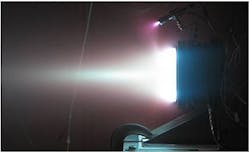DARPA asks industry for ideas on advanced thermionic and cold cathode electron emitters
ARLINGTON, Va., 20 May 2013. U.S. Government researchers are asking industry for ideas on advanced thermionic and cold cathode electron emitter technologies that operate at relatively cool temperatures to reduce complexity and enhance device lifetimes.
Scientists at the U.S. Defense Advanced Research Projects Agency (DARPA) in Arlington, Va., have issued a request for information (DARPA-SN-13-36) for the Advanced Cathode Development program, which seeks information on advanced thermionic and cold cathode electron emitter technologies for a new DARPA program to make dramatic increases in the Department of Defense (DOD) capabilities in compact, high power, high-frequency vacuum electronic devices.
Today's advanced cathodes for high-frequency vacuum electronics must operate at high temperatures to provide sufficient beam current at high current density, DARPA officials explain.
These requirements no only increase the design complexity for the device including the thermal management, magnetics, and component configuration, but also can lead to diminished lifetime, additional weight, and compromises in performance.
Officials of the DARPA Microsystems Technology Office (MTO) are asking industry for information that provides new technologies for high-current, high-current-density, and long-lifetime advanced thermionic and cold cathodes.
Cathodes must operate at a temperature of less than 1000 degrees Celsius, provide total current of at least 10 milliamps, and provide at least one hour of continuous-wave operation. Cathode technologies with performance exceeding these threshold values are of particular interest.
The cathodes also should be able to withstand operation in a power tube environment and can be build for compact, high power, high-frequency vacuum electronics.
In addition to performance, DARPA officials also seek to understand the fabrication process of the cathodes and its scalability to commercial manufacture. Submissions also should discuss the development risk of the concept and measurable progress milestones to enable accurate estimation of the resources and time frame necessary to pursue these cathodes.
Companies and universities interested should respond no later than 24 May 2013 -- this Friday -- by email to DARPA at [email protected]. Also send questions and concerns to this email address.
More information is online at https://www.fbo.gov/spg/ODA/DARPA/CMO/DARPA-SN-13-36/listing.htm.
